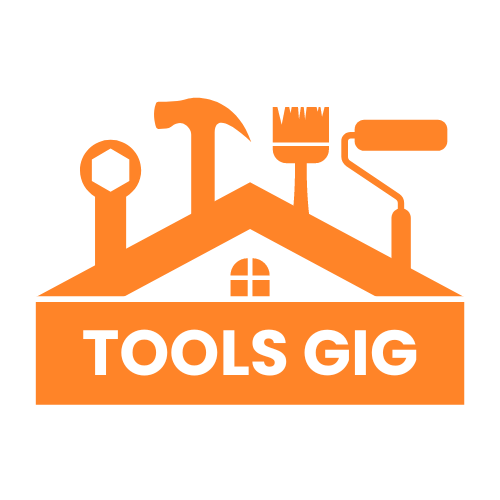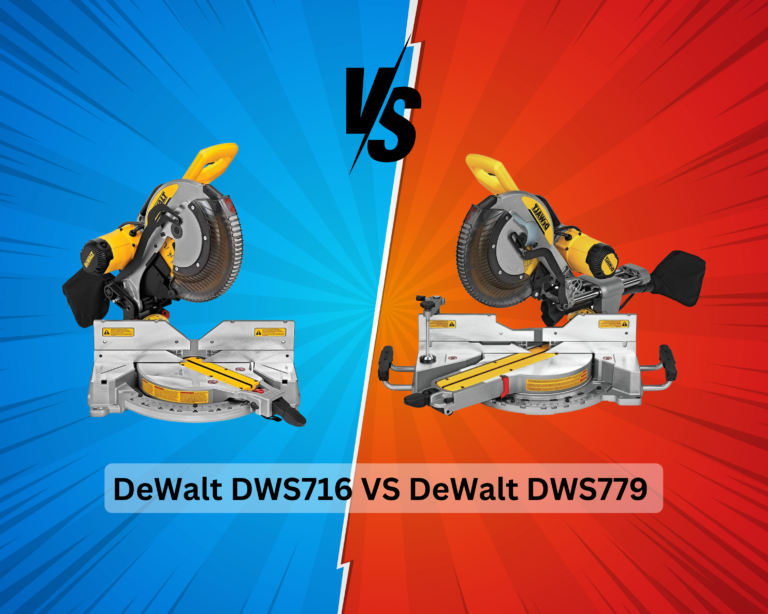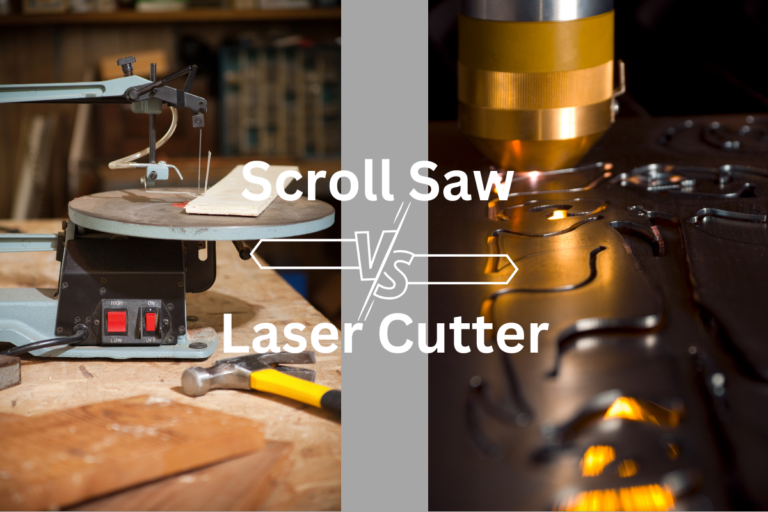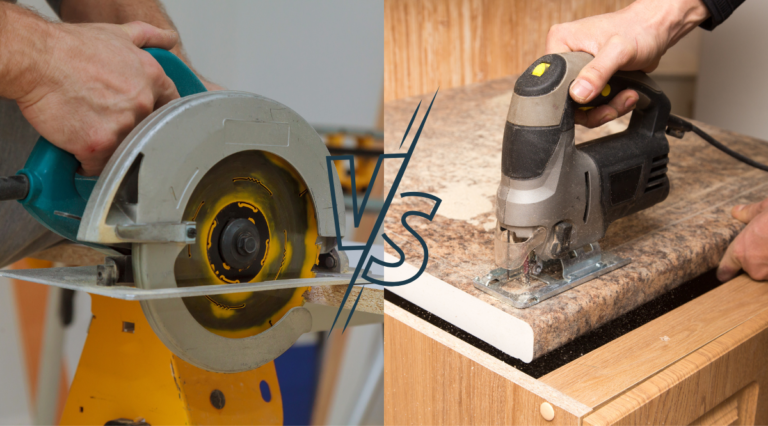Oscillating Multi Tools vs Reciprocating Saw | which one is better for you?
As an Amazon Associate I earn from qualifying purchases.
It is tough to tell which one has the most uses. First, we must consider their benefits, work environment, needs, and access to resources to compare these two tools.
Are you confused? Don’t worry; I will briefly describe these tools, their uses, pros, cons with my personal opinion in this article as simple as possible.
We all know about what reciprocating saw and oscillation multi-tools are. Here is a short note about both of the tools in my words.
Contents
Short Brief About Reciprocating Saw and Oscillation Multi-Tools
Oscillating Tools
An oscillating tool has a blade in front, not long and wide but short and narrow, which vibrates sideways at different speeds. The blades have often had chisel teeth. But there are many different kinds of blades for different uses.
We can do cutting, sanding, scraping, sawing, grinding. That’s why it is called a multi tool. The oscillating tool blades are often made from carbide steel, titanium nitride coated.
Reciprocating saw
A reciprocating saw is a machine-powered saw. It has a saw blade at the front, and the saw vibrates back and forth.
It works on the push-and-pull motion. The blades come in a variety, especially the teeth come in various shapes and sizes. The blades are often made of high carbon steel.
Swift Analysis – Oscillating Multi Tools vs Reciprocating Saw
Oscillating Tools:
Pros
- Can handle cutting, sawing, sanding, scraping, grinding.
- Blades come in different sizes and shapes.
- Very minimal amount of dust spray.
- Variable speeds offer greater control.
- It gives control to prevent clogged blades.
- Control over burned word surface.
- Control over overloading tools.
- Tool-free blade changing.
- It can come with both battery and cable powered.
- Endless accessories and attachments.
- Very portable.
- Can cut grind and sand at different angles.
Cons
- The price of the machine and accessories are high.
- The blades don’t last long.
- Repairing is much costly.
- Blades become dull very quickly.
- It makes much noise when runs at and high speed.
- Accidents can happen if not handled properly.
Reciprocating saw:
Pros
- They are very much portable.
- Comes with different blades with different teeth.
- Comes with the various speed of the blade.
- Can cut horizontally or vertically.
- Can cut most of the construction material.
- Can adjust the strokes of the blade.
- Offers safety.
- Offers great handling and control.
- Offers speed to construction jobs.
- Con be powered both by battery and cable.
- Can cut overhead.
Cons
- Can’t cut complex shapes.
- Can’t cut accurate curves.
- Machine and attachments are very costly.
- Makes much noise.
- Machines are heavier and bulkier.
The Comparison Table
| Choosing factors | Oscillating tool | Reciprocating Saw |
| Versatility | More | Less than Oscillating tool |
| Cutting Edge | Precise and smooth | Precise but little Rough |
| Beveling cuts | Easy | Little Difficult |
| Cutting Power | Less | More |
| Blade Change | Easy | Easy |
| Adjustable Depth | Yes | Yes |
| Vibration | More | Less |
| Noise | Less | More |
| Workspace | Small | A little more |
| Cutting Materials | Wood, plastic, drywall, tiles, steel, iron, cardboards | Wood, Masonite, plastic, pipe, drywall, sheet steel, steel rods, aluminum, brass, and copper |
| Wastage Amount | Less | More |
| Safety | More | Less |
Working fields:
Oscillating tools are great for making square holes, cutting something that has a small diameter, sanding any surface or complex area to reach. It is a necessary machine for plumbing and electrical works. It is also an excellent tile cutter.
On the other side, reciprocating saw is very much an alternative to a manually operated saw. I think this tool is a must-have tool for your woodshop. It is also very good at cutting pipes, tree branches, things that have a diameter of 2-4 inches.
Types and quality of cuts:
Both the machine cuts very fine and smooth. With an oscillating machine, we have to push away from us. So sometimes, with rock-solid materials, it becomes tough to cut in a straight line.
But if the blade is not dull and new, the cuts will be very smooth. It is an excellent tool for cutting rounded corners because of the many varieties of blades.
Reciprocating saw uses a front and backward motion. So, we have to push downwards, which gives us many advantages. So we can control much more and get a smooth straight cut. But it is tough to cut rounded corners with this tool.
Comparison in different circumstances:
Cutting Out And Excavating Rotted Trim:
To cut rotten wood fromwindow or door frame oscillating multi-tool is perfect for this job. As it can operate at different angles, and the blades can cut directly in the same plane.
On the other hand, the reciprocating saw can’t work because of the reciprocating motion. All the things that a handsaw can do can be done with a reciprocating saw.
Making Cuts In Hard-To-Reach Places:
In this field oscillating tool also comes first. As the machine is quite lightweight and the blade’s shape and oscillating motion help to reach very tricky places. We can slide the blade and angle the blade very easily, which helps cut in hard-to-reach areas.
Reciprocating saws are not designed for this purpose. It is good for cutting tree branches, thin logs, nails, PVC, etc.
Cutting Small Miters And Bevels:
In this field, both machines are handy tools for uses. To cut small miters and bevels the oscillating tools would be useful. Its blades are small and portable and easy to operate at an angle, perfect for making small slopes.
The reciprocating saw’s blade is quite long and like a hand saw. It’s perfect for a little long bevels and miters.
Cutting trees and Demolition work:
In this area, a reciprocating saw is a perfect tool. Its powerful back and forth motion are ideal for cutting tree branches and iron rods. But we have to understand that it can cut only a small diameter. For thick tree branches, we need a more powerful chainsaw.
The oscillating tool is suitable for cutting holes and scraping something from the plane surface. But in cutting trees and demolition work, it can’t perform very well.
For Home repairing:
For home repairing jobs, you need both of the tools. When more power is required, like cutting metals, then definitely need a reciprocating saw.
When you need to cut small holes for the electric board and where we have to be more careful oscillating saw comes in handy.
Other comparisons
Changing blades:
Changing blades of both the machine is very simple. It takes only around 1-2 minutes. You do not need to buy any third-party tool to change the blade of a reciprocating saw. But you only need an Alen key to change the blade of an oscillating tool.
Noise and vibration:
Both the tool makes noise as every power tools make. But we can adjust the speed of an oscillating tool. It makes less noise at low speed. I would say both machines are quite loud. The loudness is not more than a regular power drill.
Oscillating tools work on very fast oscillation. So it vibrates the working body more than the reciprocating saw. But if you can clamp the workpiece firmly, the vibration is not a matter of consideration. It is not strong enough to ruin your work.
Amount of Wastage:
Oscillating blades are thinner and work at very high speed. So it makes far less dust than a reciprocating saw. The dust is also not sprayed. It makes very comfortable levels of dust.
Reciprocating saw makes far more dust because of the thickness of blades and their speed. The dust is also sprayed at a large radius.
Safety:
Oscillating tools are safer than reciprocating saw. It is quite lightweight to operate. The teeth on the blades are not deep. The vibrating arc is very small, like 2 to 4 degrees. It can’t cut your skin if you touch the tip of the blade lightly. But if pressure is applied, it can cut deeply.
The reciprocating saw uses more power, and the teeth are very sharp and grooved. Small touch may result in deep cuts and harm. You have to careful using this machine.
FAQs
Is oscillating multi-tool worth it?
In many circumstances, I would say yes. We can cut, make holes, trim, sand with this only one tool. It is really good for home and professional uses. It definitely gives service worth of its price.
Can an oscillating tool cut nails and metal?
An oscillating tool definitely can cut nails and screws. A semi-circular oscillating tool can easily cut through metal sheets also. It can also cut wood very well.
Are reciprocating saws worth buying?
Definitely. It makes demolition work very easy and fun. If you have a woodshop or thinking of DIY woodworking regularly, it is a must-have tool. It lessens your labor and saves time.
What materials can I cut with a Reciprocating saw?
We can cut much variety of materials such as all kinds of wood, plastic, pipe, drywall, sheet steel, steel rods, brass, aluminum, and copper. It is also very good for cutting tree branches and logs.
Final Note:
In conclusion, I have to say in my seven years of using power tools, I have used both very frequently. Both the tools are impressive in different circumstances.
When I had to work safely, I use an oscillating tool. I had used an oscillating tool for wood sanding also. But you cannot sand a large surface with this machine.
When I needed much power, I used a reciprocating saw. It saves much of my labor. Woodcutting becomes very much easy along with cutting plastic and pipe.
I tried to cut a metal sheet once with a reciprocating saw and find out that it’s not very good in this field. It made my saw break. An oscillating tool is a good option in this field. Don’t make this mistake like me.
I wish this article helped you to understand which machine to buy according to your use. Thank you.






![U-shank Vs T-shank Jigsaw Blades [Let's Clear the Confusion] 6 U-shank Vs T-shank Jigsaw Blades](https://toolsgig.com/wp-content/uploads/2021/10/U-shank-Vs-T-shank-Jigsaw-Blades-768x314.jpg)